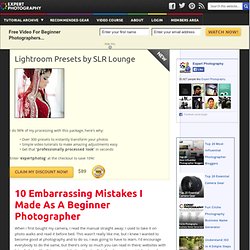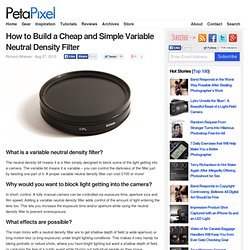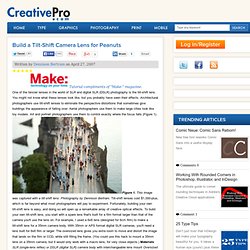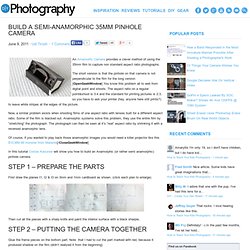

How to Create a Matrix-style "Bullet Time" Effect Using a Cheap Ceiling Fan. DIY Grid and Snoot - And What They Do. Expert Photography. Night Sky Photography Tips. Star Trails Due to the Earth’s rotation about its axis, it seems that the light from stars moves in circles around the celestial pole.

These movements are detectable after about 5 to 10 minutes, and can be traced by your camera in the form of a streak. To photograph this magical effect, you need a sturdy tripod and lots of patience. Focus the lens to infinity and set the camera’s mode at Manual or Bulb shooting mode. With the use of a cable release you will capture the stars moving across the sky. Supercharge Your Camera with Open-Source CHDK Firmware. From Wired How-To Wiki An example of the amazing high-speed captures made possible by CHDK firmware.

Photo by Keoeeit Digital cameras have powers beyond what is immediately available to the user. 10 Embarrassing Mistakes I Made As A Beginner Photographer. 1.1K Flares1.1K Flares × When I first bought my camera, I read the manual straight away; I used to take it on photo walks and read it before bed.

This wasn’t really like me, but I knew I wanted to become good at photography and to do so, I was going to have to learn. I’d encourage everybody to do the same, but there’s only so much you can read in there; websites with lots of photos like this are much better. Here’s a list of embarrassing mistakes I made. Understanding White Balance in Digital Photography.
Color Temperature.

How to Build a Cheap and Simple Variable Neutral Density Filter. What is a variable neutral density filter?

The neutral density bit means it is a filter simply designed to block some of the light getting into a camera. The variable bit means it is variable – you can control the darkness of the filter just by twisting one part of it. A proper variable neutral density filter can cost £100 or more! Why would you want to block light getting into the camera? In short; control.
What effects are possible? Build a Tilt-Shift Camera Lens for Peanuts. One of the fancier lenses in the world of SLR and digital SLR (DSLR) photography is the tilt-shift lens.

You might not know what these lenses look like, but you probably have seen their effects. Architectural photographers use tilt-shift lenses to eliminate the perspective distortions that sometimes give buildings the appearance of falling over. Aerial photographers use them to make large cities look like toy models. Art and portrait photographers use them to control exactly where the focus falls (Figure 1).
Figure 1. Figure 2. Figure 3. Figure 4. Figure 5. Figure 6. Figure 7. How to recover deleted pictures from memory card - Card Recovery Tutorial. Everybody has a digital camera these days.

More and more people use digital cameras to record wonderful moments. But it seems digital pictures are easier to lose than traditional film pictures because the digital camera has a useful but dangerous delete button or feature. Flatbed Slide, Negative Scanning Using Cut and Fold Adapter. Build A Semi-Anamorphic 35mm Pinhole Camera. An Amamorfic Camera provides a clever method of using the 35mm film to capture non standard aspect ratio photographs.

The short version is that the pinhole on that camera is not perpendicular to the film for the long version [OpenGeekWindow] You know this problem all to well from digital point and shoots. The aspect ratio on a regular point&shoot is 3:4 and the standard for printing pictures is 2:3, so you have to ask your printer (hey, anyone here still prints?) To leave white stripes at the edges of the picture. Now, a similar problem exists when shooting films of one aspect ratio with lenses built for a different aspect ratio. Some of the film is blacked out. Of course, if you wanted to play back those anamorphic images you would need a killer projector like this $10,999.99 monster from Marants[/CloseGeekWindow] In this tutorial Costas Kaounas will show you how to build an Anamorphic (or rather semi anamorphic) pinhole camera. Step 1 – Prepare The Parts Sample Images About The Author. Developing Your Style As A Photographer The Art of Photography.
Serving Professional and Amateur photographers for over years. F Stop Lounge. Info2.jpg (JPEG Image, 900 × 3300 pixels) Hacking Photography For The Love of It. Photography & Post-Production Training for Photographers. Photo effects, vintage, retro, online and free - Pixlr-o-matic. Lens Filters Explained. Lens Filters can be used for a number of different reasons such as reducing the light entering the lens allowing the shutter to stay open longer for slow shutter speed effects, adjusting the strength of reflections on the surface of water or simply adding more colour to an image.

ND (Neutral Density) Filter ND filters reduce the amount of light and colours that enter the lens in equal amounts giving you a greater choice of aperture and shutter speed. This is particularly useful when trying to achieve slow shutter speed effects during the day or in lighter conditions as the shutter speed can be slowed without over exposing the image. ND filters can be obtained in a number of different ’strengths’ for use in different conditions. ND filters can also be graduated and used for conditions where part of the scene is brighter than others. IR (Infrared) Filter An IR filter will block visible light and only allow infrared light to pass through to the camera lens. By: Werner Kunz (werkunz1) 20+ Cheatsheets & Infographics For Photographers.
We love cheatsheets as one can refer to them and make quick amendments to better our skills.

Since many loved our last compilation of cheatsheet for designers, we’ve decided to compile another set of cheatsheets, this time for photographers. Amateur photographers, and even pros can easily benefit from these cheatsheets as it is a resource for fresh and new ideas. We’ve scoured the Web and have found a wide variety of cheatsheets covering various aspects of photography and catering to the many levels of skills and interest of anyone who calls themselves a photographer. Most of the pictures you see here are cropped for a nice fit, so remember to click on the links to check out the entire cheatsheet or infographic.
Digital Photography Tips: Digital Photography School. Click it Up a Notch - Photography Tips: shooting in manual mode. 50 Incredible Photography Techniques and Tutorials. Advertisement Over the recent months we’ve been presenting various showcases of photography – while many readers hated the showcases, most readers found them inspirational and perfect for a lousy workday’s morning. However, what we should have done in the inspirational posts is not just provide you with some inspiration for your work, but also present useful photographic techniques which can help you to achieve optimal pictures for your designs. And as requested by many of you, now it’s time to correct our mistake. In this post we present useful photographic techniques, tutorials and resources for various kinds of photography.
You’ll learn how to set up the perfect environment and what techniques, principles and rules of thumbs you should consider when shooting your next perfect photo. 1.